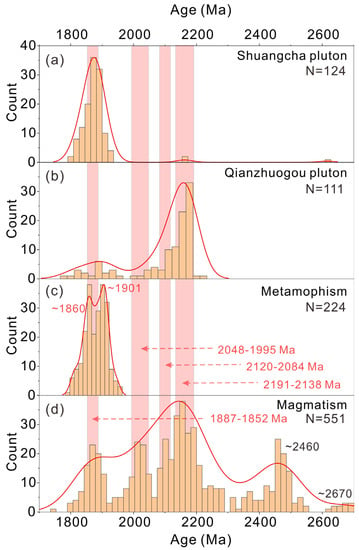The Jiao-Liao-Ji Belt (JLJB) is the most representative Paleoproterozoic orogenic belt in the North China Craton (NCC). The sedimentation, metamorphism and magmatism of the Ji’an Group and associated granites provide significant insights into the tectonic evolution of the JLJB. The rock assemblages indicate a transformation of the tectonic environment from a passive margin to an active continental margin following the onset of plate convergence and subduction. The A2-type gneissic granite (Qianzhuogou pluton) is formed in a subsequent back-arc basin extension setting at 2.20–2.14 Ga. The Ji’an Group was finally deposited in an active continental margin during the closure of a back-arc basin at 2.14–2.0 Ga. Then, the sediments were involved in a continent–arc–continent collision between the Longgang and Nangrim blocks at ~1.95 Ga. This process was accompanied by HP granulite-facies metamorphism at ~1.90 Ga. The subsequent exhumation and regional extension resulted in decompression melting during 1.90–1.86 Ga, producing metamorphism with an isothermal decompression clockwise P–T path. The resulting metapelites are characterized by perthite + sillimanite, and mafic granulites are characterized by orthopyroxene + clinopyroxene.
- Ji’an Group
- geochronology
- magmatism
- metamorphism
- Jiao-Liao-Ji Belt
1. Introduction
2. Geological Background
The NCC can be subdivided into the Western Block and the Eastern Block, as well as three Paleoproterozoic orogenic belts known as the Jiao-Liao-Ji Belt, the Trans-North China Orogen belt and the Khondalite belt [5][7][5,7]. The JLJB is located between the Nangrim and Longgang blocks in the eastern NCC (Figure 1) [11]. It consists mainly of metasedimentary rocks, meta-igneous successions and igneous rocks, including Archean–Paleoproterozoic TTG gneisses, greenschist–amphibolite–granulite facies metasedimentary rocks, various granites (gneissic granite, alkaline granite, calc-alkaline granite, porphyritic granite, etc.), bimodal volcanic rocks, mafic dykes (veins) and andesitic–rhyolitic tuffs [9][21][22][23][9,21,22,23]. The metasedimentary and meta-igneous successions consist of the Ji’an Group and Laoling Group in southern Jilin, the North Liaohe Group and South Liaohe Group in eastern Liaoning, the Jingshan Group and Fenzishan Group in eastern Shandong, and the Wuhe Group and Fengyang Group in Anhui Province (Figure 1b; [6][10][6,10]). Some scientists argue for an intracontinental rift model for the evolution of the JLJB based on the occurrence of bimodal volcanic rocks and A-type granites, coupled with the anticlockwise P–T paths [24][25][26][24,25,26], while others suggest a continent–arc or continent–continent collision model based on the occurrence of 2.2–2.1 Ga mafic–felsic intrusions and clockwise P–T paths of Paleoproterozoic metamorphism [27][28][27,28].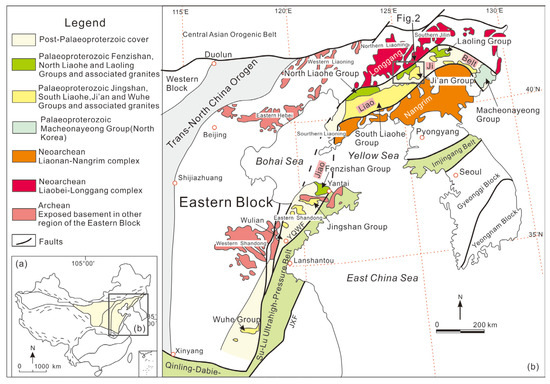
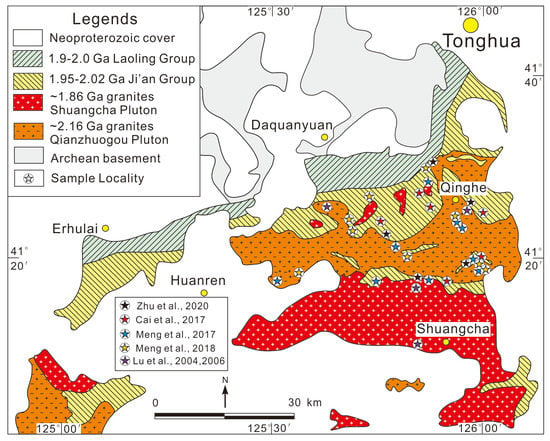
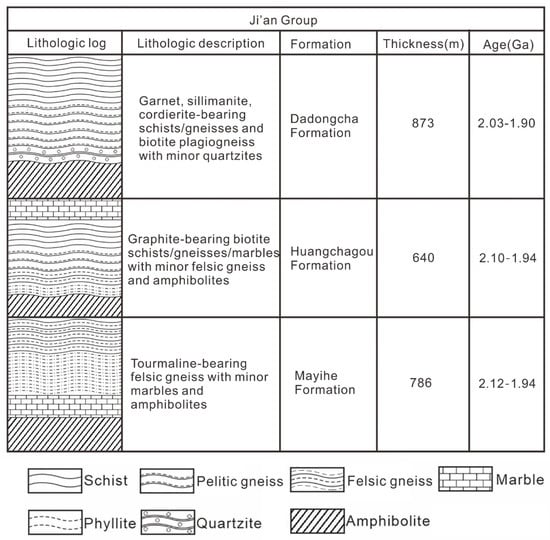
3. Representative Petrography and Microstructures
The greenschist–amphibolite–granulite facies metasedimentary and meta-igneous successions are widespread in the Ji’an Group. Within these successions, the pelitic garnet–sillimanite–cordierite–biotite gneisses and mafic clinopyroxene–orthopyroxene granulites preserve mineral assemblages consistent with granulite-facies metamorphism. The garnet–sillimanite–cordierite–biotite gneisses consist mainly of garnet (10%–15%), plagioclase (10%–15%), potassium feldspar (15%–25%), quartz (15%–20%), cordierite (20–25%), biotite (8%–10%), sillimanite (5%–8%) and small amounts of magnetite and ilmenite (1%–2%). Most garnet porphyroblasts are sieve-shaped, elongated or rounded, with a grain size of about 0.5–4 mm. Fibrous sillimanite, fine-grained biotite, quartz and ilmenite/magnetite inclusions can be found in garnet. In the matrix, acicular sillimanite, biotite, potassium feldspar and plagioclase are arranged discontinuously forming a gneissic structure. Symplectic cordierites form rims around the garnets (Figure 4c–f). The Cpx-Opx granulite is characterized by a mineral assemblage of coarse-grained clinopyroxene, orthopyroxene, garnet, amphibole, biotite, plagioclase and quartz. Clinopyroxene is dominated by diopside. Amphiboles form rims around the clinopyroxene. Inclusions of biotite grains can be observed within the clinopyroxene [30][37]. In addition, field observations show that felsic melts of varying sizes, irregular veinlets, reticulate veins and lenses of group distribution in the metapelites are associated with anatexis (Figure 4a,b).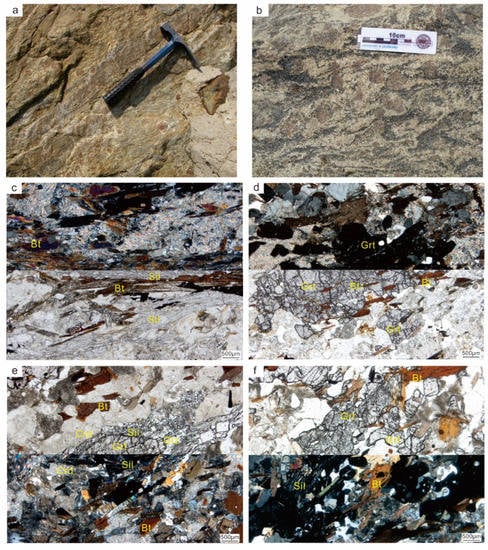
4. Metamorphic Evolution of the Ji’an Group
4.1. Peak Stage
4.2. Retrograde Stage
4.3. P–T Paths
5. Geochemistry of the Ji’an Group
5.1. Meta-Igneous Rocks
A large number of meta-igneous rocks are found in the lower section of the Ji’an Group, including pyroxene amphibolites, amphibole–plagioclase gneisses, biotite–plagioclase gneisses and felsic gneisses (Figure 56a) [34][43]. They display medium- to fine-grained granoblastic textures with subhedral–anhedral pyroxene, biotite and feldspar. Considering that the samples may have undergone dehydration and metamorphism, the mobile components cannot be used to determine the properties of the original rocks. The Nb/Y–Zr/TiO2*0.0001 diagram is effective in evaluating the original properties of the meta-igneous rocks. As shown in Figure 56b, the protoliths of the meta-igneous rocks consist mainly of calc-alkaline basalt, basaltic andesite, andesite, dacite and rhyolites.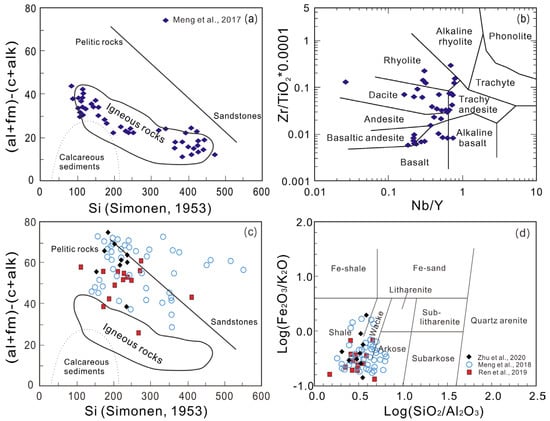
5.2. Metasedimentary Rocks
The Ji’an Group is characterized by thick successions of metasedimentary rocks, including aluminous schist, pelitic gneiss, felsic gneiss, granulite, interlayered marble and thin-bedded quartzite. The metasedimentary rocks of the Ji’an Group are generally enriched in Al2O3, depleted in CaO and FeOT, have K2O/Na2O values of >1 and contain garnet and cordierite, all of which are consistent with a metasedimentary origin. The chemical composition of sedimentary rocks depends on the composition of its source rocks. In the (al + fm)–(c + alk) diagram (Figure 56c), the data fall in the area of the pelitic sedimentary rocks. Combined with the sediment assemblage and information from the log (Fe2O3/K2O)–log (SiO2/Al2O3) diagram (Figure 56d), the protoliths of metasedimentary rocks are mainly shale, wacke, arkose, quartz sandstone and carbonate.6. Geochronology of the Ji’an Group and Related Granites
The Paleoproterozoic JLJB has a complex origin and underwent multistage evolution. The geochronology of the metasedimentary rocks and related granites can provide significant constraints on the formation of the JLJB. Based on the published zircon isotope geochronology data, zircon trace element data (e.g., Th and U) and the geochronological outline of the metamorphism and magmatism in the Ji’an Group [9][31][34][37][39][40][9,34,35,38,43,48], scholars provide constraints in the petrogenic age of the protoliths (detrital zircons with Th/U > 0.4), the metamorphic age of the metasedimentary rocks (metamorphic zircons with Th/U < 0.1) and the Paleoproterozoic magmatism (magmatic zircons with Th/U > 0.4). The metamorphic zircons in the Ji’an Group suggest that the metamorphism can be divided into two periods of 1950–1870 Ma and 1870–1800 Ma, with peak ages of 1901 Ma and 1860 Ma, respectively (Figure 67c). The ages of metamorphic zircons are consistent with the metamorphic events at 1.90 and 1.85 Ga suggested by Meng et al. [34][43]. Additionally, the younger ages down to 1800 Ma may indicate a cooling stage. The detrital zircons in the Ji’an Group show four statistical ages of 2191–2138, 2120–2084, 2048–1995 and 1887–1852 Ma, with peak ages of 2670 and 2460 Ma (Figure 67d). These data suggest four periods of magmatism in the Paleoproterozoic JLJB. The magmatic zircons of the porphyritic granite (Shuangcha pluton) are mainly concentrated in 1887–1852 Ma with ages of ~2175 Ma and ~2625 Ma. The magmatic zircons of the gneissic granite (Qianzhuogou pluton) yield ages of 2200–1800 Ma with peaks at 2191–2138 Ma. Consequently, scholars conclude that the gneissic granite was formed at 2191–2138 Ma, with a few zircon records of later magmatic events. The porphyritic granite was formed at 1887–1852 Ma and preserved inherited zircons with ages of ~2175 Ma and ~2625 Ma (Figure 67a,b).